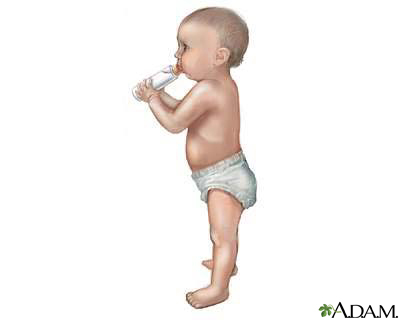Cow's milk and children
Alternative Names
Milk and children; Cow's milk allergy - children; Lactose intolerance - children
Information
You may have heard that cow's milk should not be given to babies younger than 1 year old. This is because cow's milk doesn't provide enough of certain nutrients. Also, it's hard for your baby to digest the protein and fat in cow's milk. It is safe though, to give cow's milk to children after they're 1 year old.
A child who is 1 or 2 years old should only drink whole milk. This is because the fat in whole milk is needed for your child's developing brain. After 2 years old, children can drink low-fat milk or even skim milk if they are overweight.
Some children have problems from drinking cow's milk. For instance, a milk allergy may cause:
- Belly pain or cramping
- Nausea and vomiting
- Diarrhea
A severe allergy can cause bleeding in the intestines that can lead to anemia. But only about 1% to 3% of children under 1 year old have a milk allergy. It is even less common in children who are older than 1 to 3 years.
Lactose intolerance occurs when the small intestine does not make enough of the enzyme lactase. A child who is lactose intolerant can't digest lactose. This is a type of sugar found in milk and other dairy products. The condition can cause bloating and diarrhea.
If your child has one of these problems, your health care provider may recommend soy milk. But many children who are allergic to milk are also allergic to soy.
Children usually outgrow allergies or intolerances by the time they are 1 year old. But having one food allergy increases the risk for having other types of allergies.
If your child can't have dairy or soy, talk to your provider about other food options that will help your child get enough protein and calcium.
The US Department of Agriculture recommends the following daily amounts of dairy for children and teens:
- Two through 3 years old: 2 cups (480 milliliters)
- Four through 8 years old: 2½ cups (600 milliliters)
- Nine through 18 years old: 3 cups (720 milliliters)
One cup (240 milliliters) of dairy equals:
- One cup (240 milliliters) of milk
- Eight ounces (240 milliliters) of yogurt
- Two ounces (56 grams) of processed American cheese
- One cup (240 milliliters) of pudding made with milk
Gallery

References
Centers for Disease Control and Prevention website. Fortified cow’s milk and milk alternatives. www.cdc.gov/nutrition/infantandtoddlernutrition/foods-and-drinks/cows-milk-and-milk-alternatives.html. Updated July 23, 2021. Accessed December 6, 2021.
Marion G, Venter C. Management of food allergy. In: Leung DYM, Akdis CA, Bacharier LB, et al, eds. Pediatric Allergy: Principles and Practice. 4th ed. Philadelphia, PA: Elsevier; 2021:chap 35.